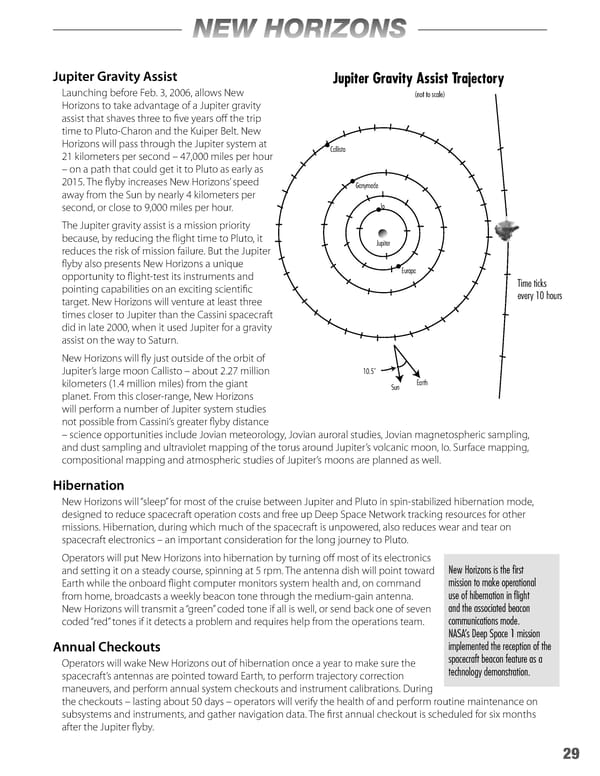NEW HORIZONS Jupiter Gravity Assist Jupiter Gravity Assist Trajectory Launching before Feb. 3, 2006, allows New (not to scale) Horizons to take advantage of a Jupiter gravity assist that shaves three to five years off the trip time to Pluto-Charon and the Kuiper Belt. New Horizons will pass through the Jupiter system at �������� 21 kilometers per second – 47,000 miles per hour – on a path that could get it to Pluto as early as 2015. The flyby increases New Horizons’ speed �������� away from the Sun by nearly 4 kilometers per second, or close to 9,000 miles per hour. �� The Jupiter gravity assist is a mission priority because, by reducing the flight time to Pluto, it ������� reduces the risk of mission failure. But the Jupiter flyby also presents New Horizons a unique ������ opportunity to flight-test its instruments and ���������� pointing capabilities on an exciting scientific �������������� target. New Horizons will venture at least three times closer to Jupiter than the Cassini spacecraft did in late 2000, when it used Jupiter for a gravity assist on the way to Saturn. New Horizons will fly just outside of the orbit of Jupiter’s large moon Callisto – about 2.27 million ����� kilometers (1.4 million miles) from the giant ��� ����� planet. From this closer-range, New Horizons will perform a number of Jupiter system studies not possible from Cassini’s greater flyby distance – science opportunities include Jovian meteorology, Jovian auroral studies, Jovian magnetospheric sampling, and dust sampling and ultraviolet mapping of the torus around Jupiter’s volcanic moon, Io. Surface mapping, compositional mapping and atmospheric studies of Jupiter’s moons are planned as well. Hibernation New Horizons will “sleep” for most of the cruise between Jupiter and Pluto in spin-stabilized hibernation mode, designed to reduce spacecraft operation costs and free up Deep Space Network tracking resources for other missions. Hibernation, during which much of the spacecraft is unpowered, also reduces wear and tear on spacecraft electronics – an important consideration for the long journey to Pluto. Operators will put New Horizons into hibernation by turning off most of its electronics and setting it on a steady course, spinning at 5 rpm. The antenna dish will point toward New Horizons is the first Earth while the onboard flight computer monitors system health and, on command mission to make operational from home, broadcasts a weekly beacon tone through the medium-gain antenna. use of hibernation in flight New Horizons will transmit a “green” coded tone if all is well, or send back one of seven and the associated beacon coded “red” tones if it detects a problem and requires help from the operations team. communications mode. NASA’s Deep Space 1 mission Annual Checkouts implemented the reception of the Operators will wake New Horizons out of hibernation once a year to make sure the spacecraft beacon feature as a spacecraft’s antennas are pointed toward Earth, to perform trajectory correction technology demonstration. maneuvers, and perform annual system checkouts and instrument calibrations. During the checkouts – lasting about 50 days – operators will verify the health of and perform routine maintenance on subsystems and instruments, and gather navigation data. The first annual checkout is scheduled for six months after the Jupiter flyby. 29
 New Horizons Page 38 Page 40
New Horizons Page 38 Page 40